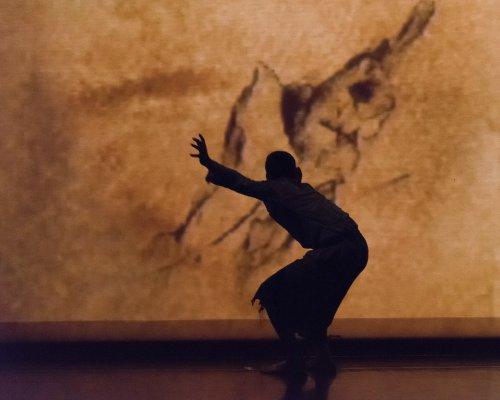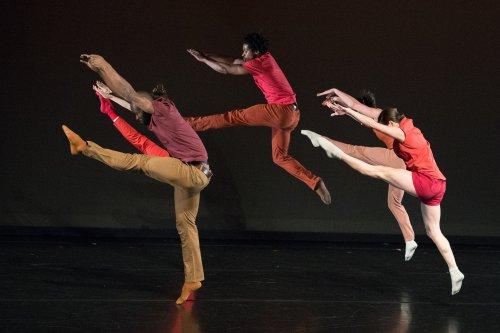Battery Dance – Spring 2017 Season
A downtown dance troupe matures into an expressive voice for refugees and their plight.

Hussein Smko in a scene from Battery Dance’s production of Jonathan Hollander’s “On Foot,” artwork by Kevork Mourad (Photo credit: Dariel Sneed)
[avatar user=”Joel Benjamin” size=”96″ align=”left” ] Joel Benjamin, Critic[/avatar]The Battery Dance company has had a checkered past but has always been a valued presence in Lower Manhattan. The troupe celebrated its 41st New York season with two days of performances at the Schimmel Center at Pace University.
To say that this dance company has matured is an understatement. The four premieres displayed a maturity in subject matter and a professional level of dancing that should make Jonathan Hollander, Battery’s founder and artistic director, very proud.
The Battery Dance company has—head on—taken on the huge issue of modern day refugees. The four new works reflected this with varying degrees of success. All were quality ballets, but the last, “On Foot,” was outstanding.
The dancers were all fine and stood out individually, but this season had the added advantage of an engaging newcomer, Hussein Smko, whose personal story echoes the refugee theme. Smko is not a well-trained dancer, but had a great stage presence and charisma.
“Double Knot,” was choreographed and danced by Sean Scantlebury who joined Smko in a twisty, energetic duet. Dressed in street clothes, the two mostly moved in unison using their own breaths to time themselves. The choreography was a hybrid of street dancing and freewheeling modern dance and the two acquitted themselves well. Scantlebury and Smko came across as great friends.

A scene from Battery Dance’s Reconstruction” (Photo credit: Dariel Sneed)
“Reconstruction” was a six-part suite of short dances each choreographed by a member of the troupe to a series of musical bits by Matmos, using themes from Civil War times. The dancers wore casual shirts and pants in variations of pale orange (uncredited) and began with Scantlebury’s “Hear Ye, Hear Ye!” choreographed on Robin Cantrell, Mira Cook and Bethany Mitchell who tiptoed in and playfully pulled off each other. Each section had a political/military name: “Hail to the Chiefs” (Razvan Stoian), “Unrest” (Clement Mensah), “Call to Arms” (Mitchell), “Marching Orders” (Cantrell) and “Humanity Remains” (Cook). The last two were the best. “Marching Orders” had the heartbreaking image of members of the cast slowly turning away from the group to slowly march off into the wings and implied combat. “Humanity Remains,” though a tad naïve in its rah-rah quality, brought the work to an optimistic end.
In “Echoes of Erbil” Smko got to show off his prowess in his own solo. Bare-chested and wearing white jeans, he combined modern dance with movements reminiscent of the Kurdish area of Iraq, delicate hand gestures, soft stomps and detailed use of the shoulders and head. He also sang and spoke, often sounding desperate and sad. He needs to work more on form, but this was a great beginning.

A scene from Battery Dance’s production of Jonathan Hollander’s “On Foot” (Photo credit: Dariel Sneed)
The final work, “On Foot” was choreographed by Hollander and seven company members. It featured a Middle East-tinged score by Kinan Azmeh and Anouar Brahem and sensational visual art, mostly created on the spot, by Kevork Mourad whose ancestors fled the Armenian genocide. Mourad created both beautiful and horrifying projections on the back screen of the stage and also sat at a computer projector producing fluidly morphing images on a scrim: people floated about; ancient buildings melted; and complex landscapes passed by capturing the mood of the choreography.
Dressed in Tyler Holland’s perfectly realized drab, pale blue costumes, the cast did the impossible: they molded dance and art into a dramatic whole to catch the devastation and horror of the current flood of emigrants out of Syria and other Middle Eastern countries.
In a stylized, yet effective way, the work caught the political and physical abuses they suffered, all the while making it clear that their spirit and grit kept them pushing onward to unknown destinations. Somehow, the research of the dancers—and the presence of real, live political refugees in the company—gave them the intimate knowledge to portray these unnamed masses. Healthy, good-looking dancers morphed into living, breathing metaphors.
The actual choreography was quite simple, melding with the continuously changing art and the music. Lines of dancers staggered, split off into solos and duets that communicated specific characters like mothers, lovers, warriors, soldiers and a welcome calm section in which the entire group sat in a circle and enjoyed dancing, eating and a moment’s rest, after which they trudged off as the lights faded.
“On Foot,” despite the technical demands involved in its staging, needs to be seen. It might just spark new empathy for these courageous trekkers and their cause.
The subtle lighting throughout was by Barry Steele.
Battery Dance (May 10 & 11, 2017)
Schimmel Center at Pace University, 3 Spruce Street, in Manhattan
For tickets, call 212-346-1715 or visit http://www.batterydance.org or http://www.SchimmelCenter.org
Running time: one hour and 45 minutes including one intermission




Leave a comment